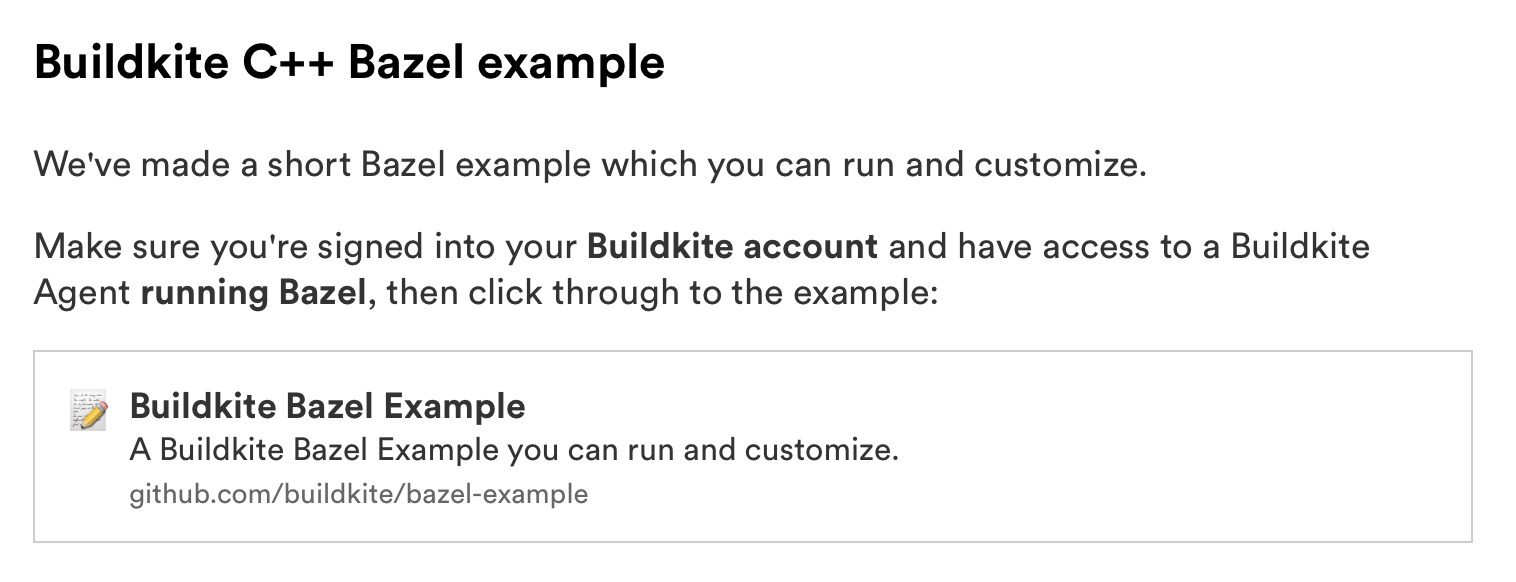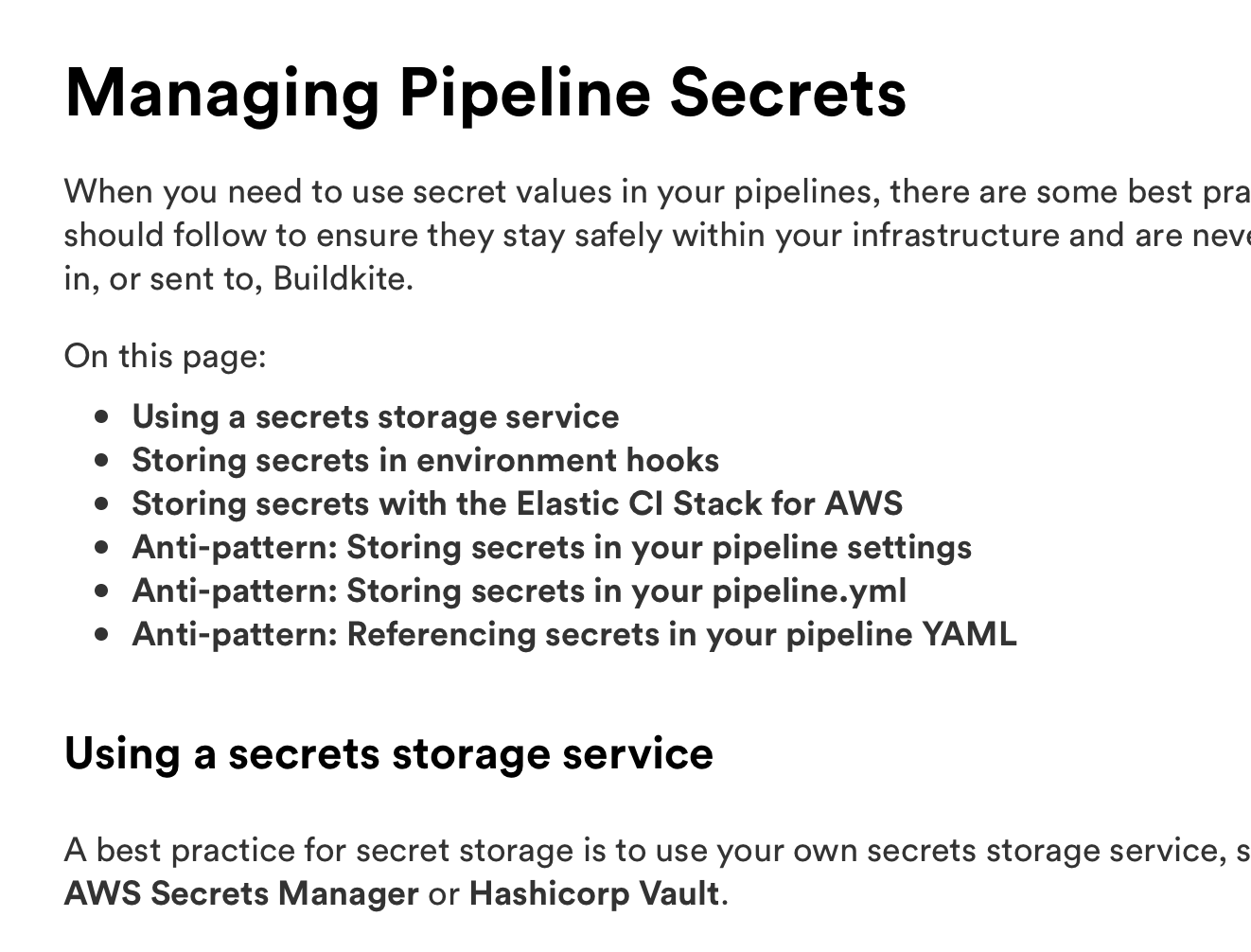GraphQL resource id is available on the REST API
As part of the transition to GraphQL, we have added graphql_id for the following REST API resources. The graphql_id is used to target specific resources when running queries and mutations on GraphQL API.
- Agent
- Build
- Job
- Organization
- Pipeline
- Team
- User
Here is an example response from pipelines which includes graphql_id:
{
"id": "849411f9-9e6d-4739-a0d8-e247088e9b52",
"graphql_id": "UGlwZWxpbmUtLS1lOTM4ZGQxYy03MDgwLTQ4ZmQtOGQyMC0yNmQ4M2E0ZjNkNDg=",
"url": "https://api.buildkite.com/v2/organizations/acme-inc/pipelines/my-pipeline"
}If you have any questions or feedback, please let us know in the Forum or send us an email 📨
Juanito
Custom states for blocked builds
With the new block step attribute, blocked_state, you can specify what state the build should have when it’s blocked by each block step — green passed, yellow running, or red failed.
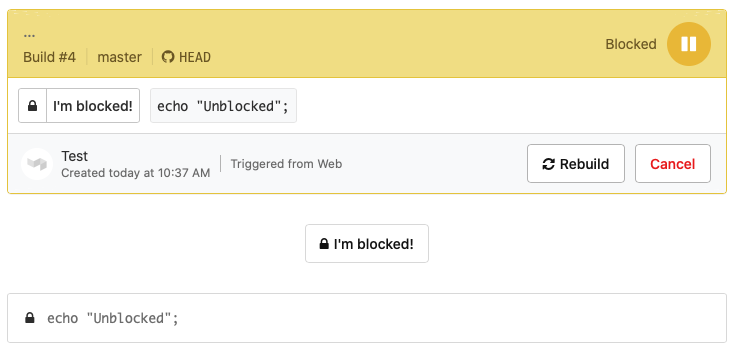
When you’ve got a block step that requires user input, having the build look or behave like it's passed isn’t always what you want. Setting blocked_state will affect the build state within the Buildkite UI, source provider integrations, webhooks, and notifications. This gives you more control over how your builds interact with PRs and custom integrations.
Add the new blocked_state attribute to your block steps to change the blocked status colour from the default green.
Grant
Branch filter pattern changes
You can now mix positive and negative branch filter patterns for more precise control over which branches to build 🔀
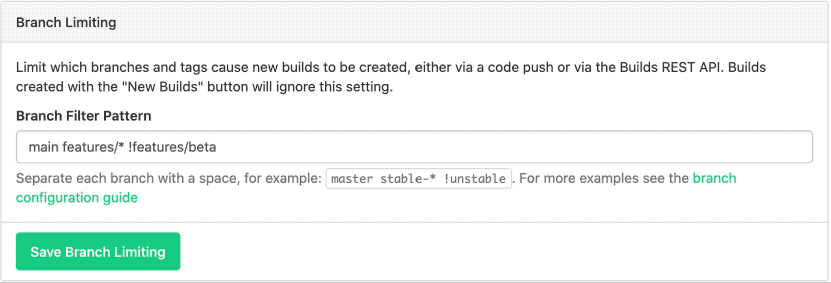
We've done our best to reach out via email if your pipeline already had a mix of patterns that will be affected by this change 👋🏻
If you're seeing unexpected builds, or are left waiting for a build that isn't showing up, we'd suggest a quick review of your pipeline's branch filter patterns.
For more information on branch filter patterns and some example code, check out the updated branch configuration docs.
Samuel
Elastic CI Stack for AWS v5.0.0
We've released a new major version of the Elastic CI Stack 🌈
The latest version includes:
- Experimental Windows Server 2019 support
- Support for four new regions: ap-east-1 (Hong Kong), me-south-1 (Bahrain), af-south-1 (Cape Town), eu-south-1 (Milan)
- Support for managing Agent tokens with AWS SSM
- A blazing fast Agent Auto Scaler by AWS Lambda - up to 300% faster initial scale-ups compares to previous AutoScaling rules
And much, much more! Check out the full changelog for this release on GitHub.
We'd love for you to share any feedback you have on the v5 announcement post in our forum 🤓
Thank you to the many users who provided bug reports and contributions that made this release possible 💚
Juanito
An all new Timeline tab
Debugging job and agent issues has become a whole lot easier with the shiny updates we've just released to the Timeline tab 📖
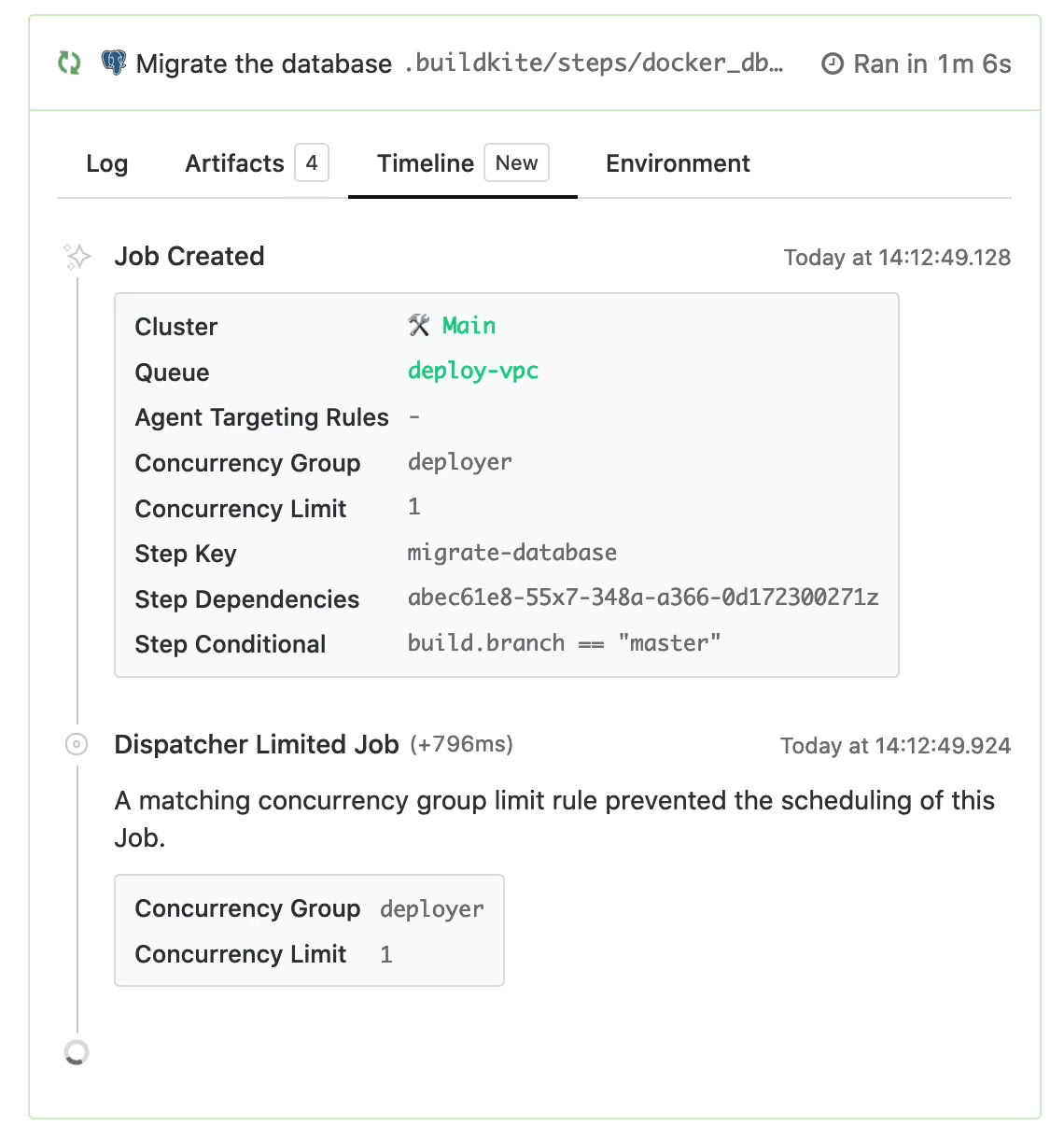
The new and improved Timeline tab has:
- Live updating with agent events
- Events from the dispatcher showing when the jobs are scheduled and assigned, and
- All your job info in one place including concurrency groups, step dependencies, and conditionals
You can find all of these updates under the Timeline tab of any job 🕵🏻♀️
Jessica
GitHub App integration
See exactly which repo permissions are requested by Buildkite with our new GitHub App 
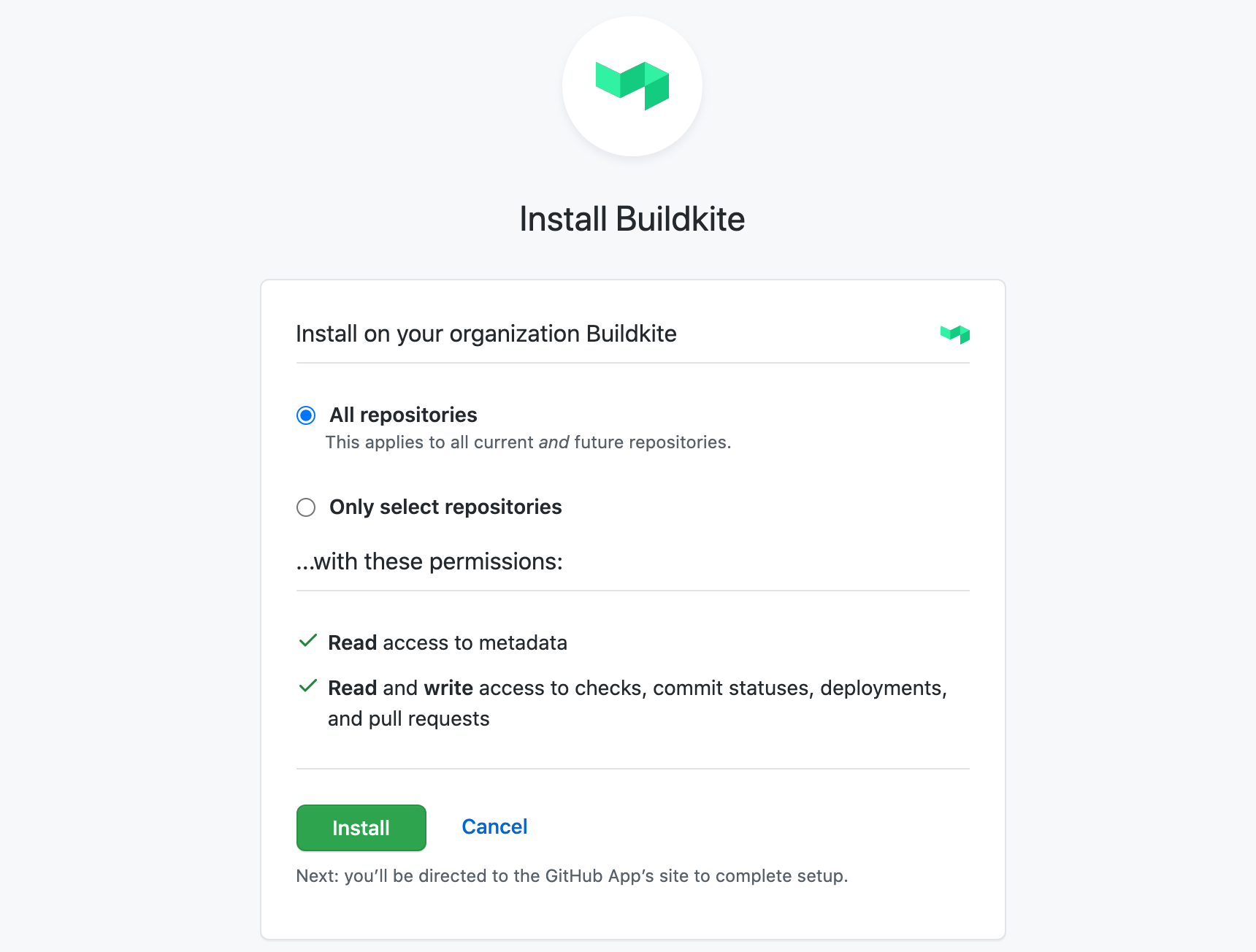
GitHub Apps create a direct connection between your Buildkite and GitHub organizations, removing reliance on individual user connections. GitHub Organization Admins can then see permissions and manage access on a per-repo basis 🙌🏻
Get started by installing the GitHub App from your Repository Providers page.
Samuel
New Repository Providers page
We've made it easier to manage multiple source control integrations 🔀 You can now find a list of connected and available integrations on the new Repository Providers page
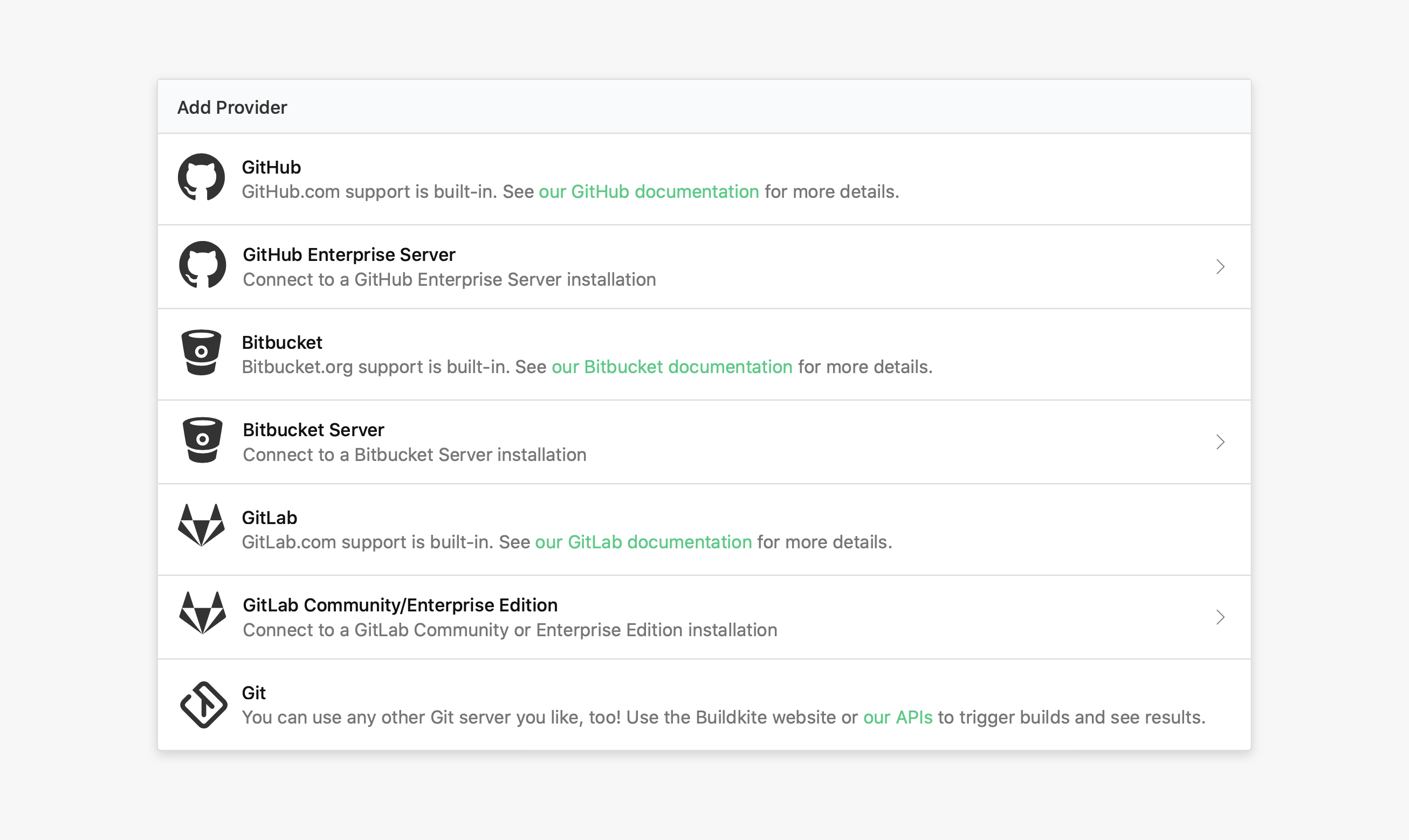
Click through to each provider for settings and delete options ⚙️
Sam
Skipped builds now use "error" for GitHub commit statuses
Skipped builds are now marked as an "error" in GitHub commit statuses:
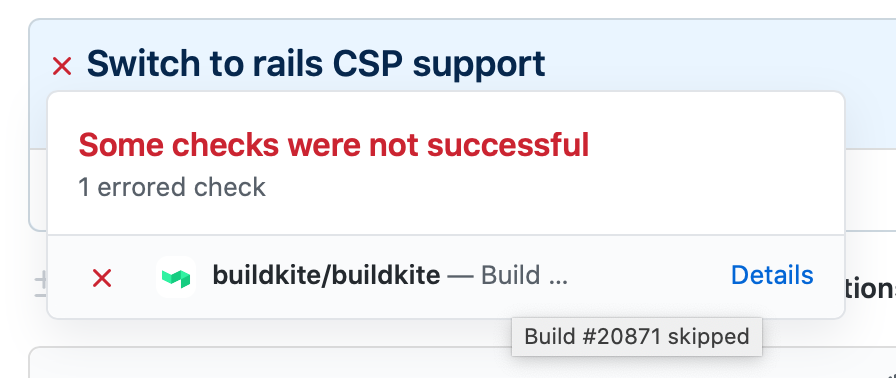
Build skipping, available from your Buildkite pipeline settings, saves you time by only testing the latest commit on a branch. Previously, a skipped build created a "success" commit status on GitHub, but this could give the false impression that the tests were run and passed.
The options here are pretty limited, but we've made this change to better reflect that the build is no longer pending, but didn't succeed or fail, it finished unusually.
Running another build on the same commit will replace this error status, and running builds on future commits will correctly update a pull request as expected.
Samuel
Laying the groundwork for Buildkite on Apple Silicon Macs
We’ve taken some steps to ensure that the Buildkite Agent is ready for upcoming Macs running on Apple Silicon. 👩🏻💻✨
First things first, we are eagerly anticipating Go, the language the Agent is written in, gaining the ability to build macOS binaries specifically for Apple Silicon, and plan to provide such binaries as soon as it’s feasible to do so.
Currently we suggest the 64-bit Intel amd64 binary, which happily runs under Rosetta 2 on Apple Silicon. 🦾
For those already adventuring on early Apple Silicon Macs, we’ve verified that our Homebrew-based Mac installation instructions work just fine there. Our non-Homebrew and Linux install script has also been updated to ensure it picks the correct binary on Apple Silicon Macs.
Both of these installation options will install the 64-bit Intel binary, and while the Agent itself will run within Rosetta 2, running an Apple Silicon binary or test suite within your builds should work just fine. We don’t anticipate any obvious issues with this configuration, but please report any issues you do encounter to us.
We have also decided to stop providing 32-bit Intel 386 binaries for macOS as of the next Agent release. This is intended to avoid confusion due to the fact that neither current Macs running macOS Catalina nor upcoming Apple Silicon Macs can run them. For those curious, since early 2018, only the 64-bit Intel binaries have been supplied via our Homebrew formula. If you have a specific need for a 32-bit Intel Mac binary, building the Agent yourself will likely work for the foreseeable future.
To the Linux, BSD and Windows users out there; we have no plans to stop providing 32-bit Intel binaries for your platforms. ✌🏼
If you have any questions we haven’t covered here, or run into some issues in your continuing adventures, please let us know via support@buildkite.com.
Jessica
Bazel docs and example pipeline
We've added new documentation on how to run Bazel on Buildkite, including a GitHub repository and example pipeline 📗
Check out the new Using Bazel on Buildkite documentation for details, with links to the example repository and further reading.
Sam
12 new conditionals now available
Since adding conditionals support we've added the following 11 new variables and one new function 🎉
build.env()build.author.emailbuild.author.idbuild.author.namebuild.author.teamsbuild.commitbuild.creator.emailbuild.creator.idbuild.creator.namebuild.creator.teamsbuild.pull_request.draftbuild.source
You can find full descriptions of all the available variables in the Using Conditionals guide, as well as new code samples 💫
Harriet
Blocked builds now considered "Fixed"
Buildkite can send notifications to your favourite Slack channel when your builds have finished. These notifications can be filtered in a few different ways, including to only "failed" and "fixed" builds. Historically, "fixed" meant there was a previous build on the same branch which failed and the new build has passed. Now "fixed" is also sent when a new build becomes blocked.
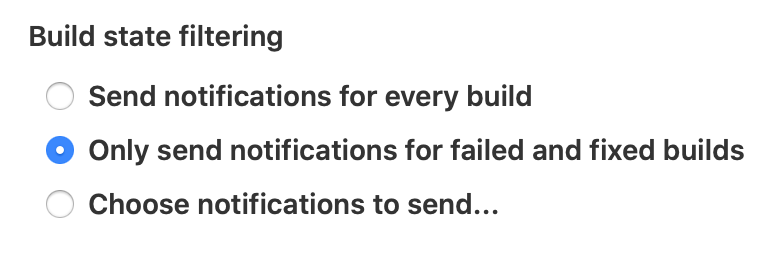
We've tried to make this change carefully so that existing notifications are mostly unaffected, apart from "fixed" notifications appearing when builds become blocked. If this interrupts your workflow, please reach out via support@buildkite.com.
Samuel
Timed out jobs that exit with 0 will now pass
Previously, the build would consider a timed out job as "failed", regardless of its exit status 🙃
This could sometimes happen if a command finished just as the job was being timed out, or if it had specifically implemented signal handling to gracefully exit.
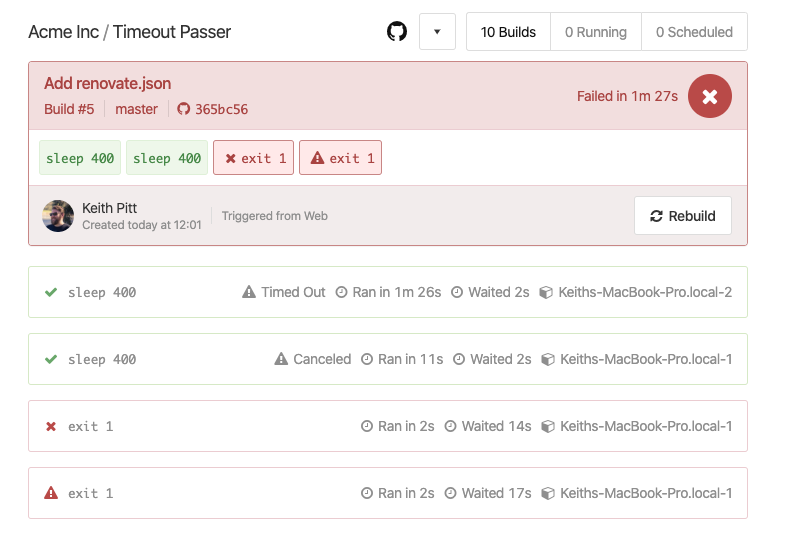
Now, jobs that timeout with an exit status of 0 will be marked as "passed", so you can depend on the exit status as the one source of truth for job status ✅
Harriet
Embed colored terminal output in Annotations
You can now more easily embed colored terminal output in annotations. 🌈
Wrap any ANSI formatted console output in a Markdown block with either the term or terminal syntax:
```term
Fancy \x1b[91mc\x1b[33mo\x1b[93ml\x1b[92mo\x1b[94mr\x1b[95ms\x1b[0m here
```The ANSI formatting is then rendered for you in the annotation:
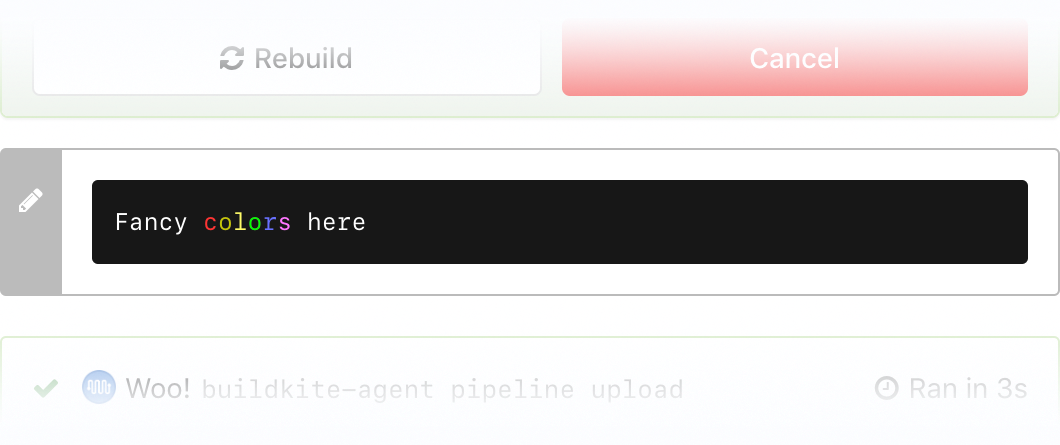
You can read more about the formatting supported in annotations in the CLI docs.
Jessica
Schedules no longer need a user
Builds created from schedules will no longer be associated with users 🏃🏼♂️💨
If a user loses access to a pipeline, either by leaving the organization or changing teams, you won't need to update your schedules to a new owner.
If your schedule is still attached to a user, you'll see the ⚠️ Requires Migration badge. You'll be able to remove the user from the schedule on the build schedule page.

Unmigrated schedules will have their users automatically removed on the 30th of January, 2020. To check your build schedules, see the Schedules section of your Pipeline Settings 👀
Harriet
Identify if you’re running an agent version with known issues
To make it easier to see if you’re running an agent version with a known issue, we've updated the agent list, job timeline, and agent page to show a warning and a link to upgrade instructions 🐛
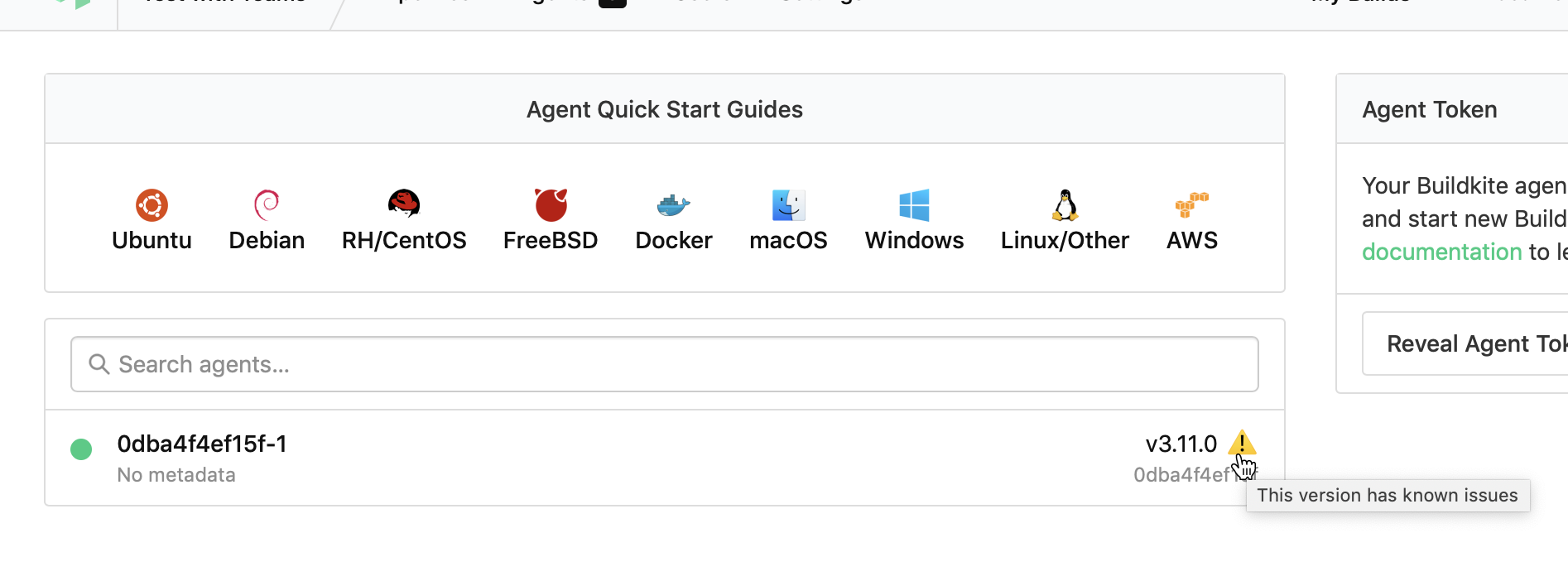
Upgrade instructions all link to their relevant buildkite-agent GitHub release, so you can dig into the details and find the minimum required version bump.
Tim
Job navigation now stays on-screen as you scroll
To make it easier to navigate long build pages, we’ve updated the job navigation so that it sticks to the top of your browser window as you scroll 🔝
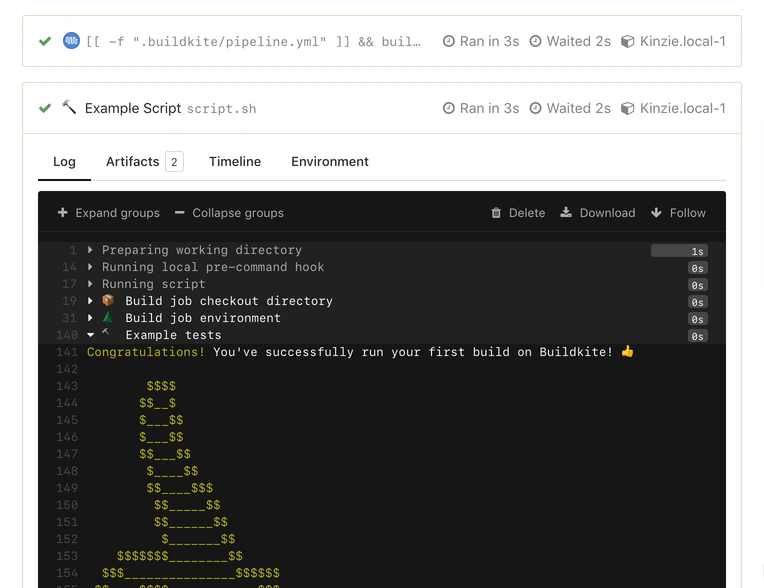
Now you can keep your bearings while spelunking through long build output or tracking down that particular artifact 🔍
Jessica
Guidelines for managing pipeline secrets
We've added a new Managing Pipeline Secrets guide to help you understand how to securely store and access secrets, and some of the anti-patterns you should avoid 🔐
Have a read through the recommendations and share it with your team 💪
Harriet
Support for selecting multiple options in block steps
We’ve added a new multiple property to block steps, giving you the ability to select multiple options when unblocking builds ☑️
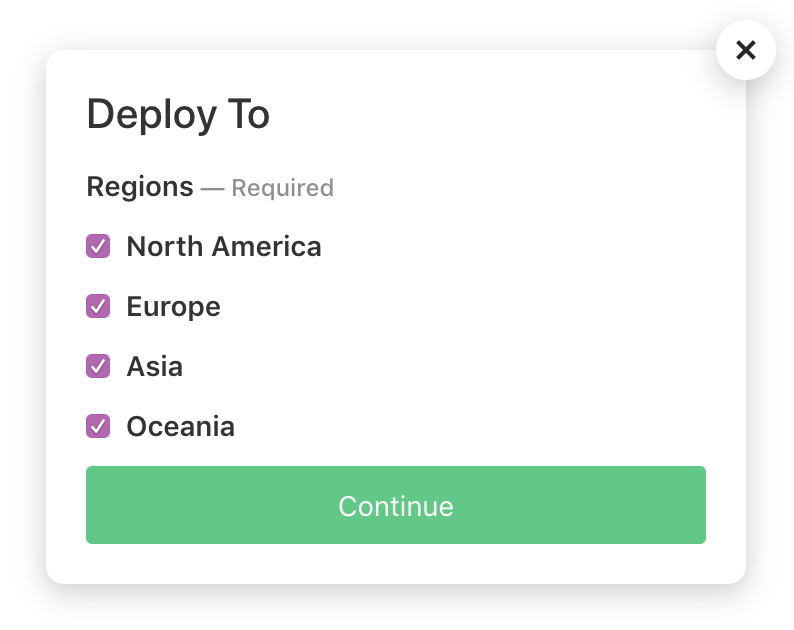
When the build is unblocked with multiple selected options, the meta-data value will return the options as a newline separated string.
See the block step documentation for more details and examples.
Jessica
View all branches on the pipelines overview page
Your pipeline overview page uses each pipeline’s default branch to calculate the graphs and statistics. We've added support for setting a pipeline's default branch to a blank value (which you can now do directly on the pipelines page), allowing you to see the graphs and stats for all builds in a pipeline 📊
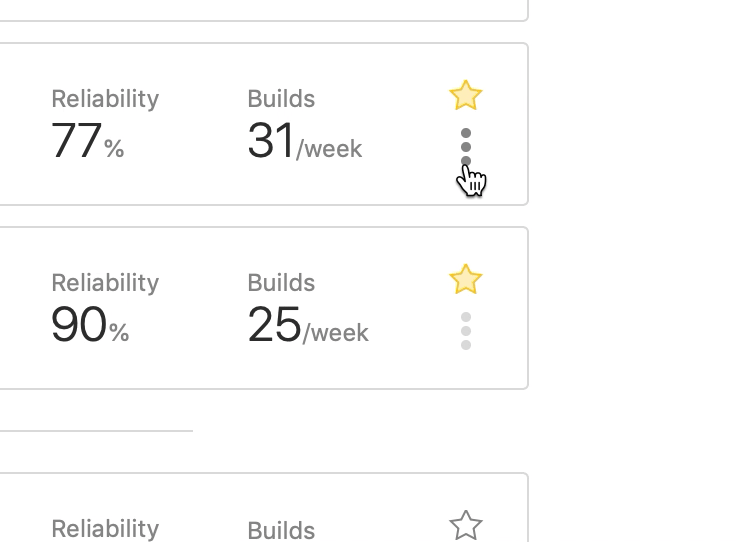
Harriet
Start turning complexity into an advantage
Create an account to get started for free.


